Andrea Paudice
Uniform Mean Estimation for Heavy-Tailed Distributions via Median-of-Means
Jun 18, 2025Abstract:The Median of Means (MoM) is a mean estimator that has gained popularity in the context of heavy-tailed data. In this work, we analyze its performance in the task of simultaneously estimating the mean of each function in a class $\mathcal{F}$ when the data distribution possesses only the first $p$ moments for $p \in (1,2]$. We prove a new sample complexity bound using a novel symmetrization technique that may be of independent interest. Additionally, we present applications of our result to $k$-means clustering with unbounded inputs and linear regression with general losses, improving upon existing works.
Revisiting Agnostic Boosting
Mar 12, 2025Abstract:Boosting is a key method in statistical learning, allowing for converting weak learners into strong ones. While well studied in the realizable case, the statistical properties of weak-to-strong learning remains less understood in the agnostic setting, where there are no assumptions on the distribution of the labels. In this work, we propose a new agnostic boosting algorithm with substantially improved sample complexity compared to prior works under very general assumptions. Our approach is based on a reduction to the realizable case, followed by a margin-based filtering step to select high-quality hypotheses. We conjecture that the error rate achieved by our proposed method is optimal up to logarithmic factors.
General Tail Bounds for Non-Smooth Stochastic Mirror Descent
Dec 12, 2023Abstract:In this paper, we provide novel tail bounds on the optimization error of Stochastic Mirror Descent for convex and Lipschitz objectives. Our analysis extends the existing tail bounds from the classical light-tailed Sub-Gaussian noise case to heavier-tailed noise regimes. We study the optimization error of the last iterate as well as the average of the iterates. We instantiate our results in two important cases: a class of noise with exponential tails and one with polynomial tails. A remarkable feature of our results is that they do not require an upper bound on the diameter of the domain. Finally, we support our theory with illustrative experiments that compare the behavior of the average of the iterates with that of the last iterate in heavy-tailed noise regimes.
An Improved Uniform Convergence Bound with Fat-Shattering Dimension
Jul 13, 2023Abstract:The fat-shattering dimension characterizes the uniform convergence property of real-valued functions. The state-of-the-art upper bounds feature a multiplicative squared logarithmic factor on the sample complexity, leaving an open gap with the existing lower bound. We provide an improved uniform convergence bound that closes this gap.
Active Learning of Classifiers with Label and Seed Queries
Sep 08, 2022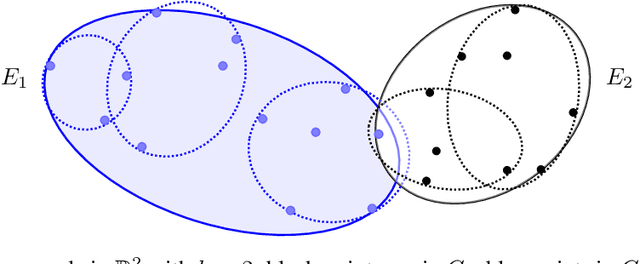

Abstract:We study exact active learning of binary and multiclass classifiers with margin. Given an $n$-point set $X \subset \mathbb{R}^m$, we want to learn any unknown classifier on $X$ whose classes have finite strong convex hull margin, a new notion extending the SVM margin. In the standard active learning setting, where only label queries are allowed, learning a classifier with strong convex hull margin $\gamma$ requires in the worst case $\Omega\big(1+\frac{1}{\gamma}\big)^{(m-1)/2}$ queries. On the other hand, using the more powerful seed queries (a variant of equivalence queries), the target classifier could be learned in $O(m \log n)$ queries via Littlestone's Halving algorithm; however, Halving is computationally inefficient. In this work we show that, by carefully combining the two types of queries, a binary classifier can be learned in time $\operatorname{poly}(n+m)$ using only $O(m^2 \log n)$ label queries and $O\big(m \log \frac{m}{\gamma}\big)$ seed queries; the result extends to $k$-class classifiers at the price of a $k!k^2$ multiplicative overhead. Similar results hold when the input points have bounded bit complexity, or when only one class has strong convex hull margin against the rest. We complement the upper bounds by showing that in the worst case any algorithm needs $\Omega\big(k m \log \frac{1}{\gamma}\big)$ seed and label queries to learn a $k$-class classifier with strong convex hull margin $\gamma$.
Regret Analysis of Dyadic Search
Sep 02, 2022
Abstract:We analyze the cumulative regret of the Dyadic Search algorithm of Bachoc et al. [2022].
High Probability Bounds for Stochastic Subgradient Schemes with Heavy Tailed Noise
Aug 17, 2022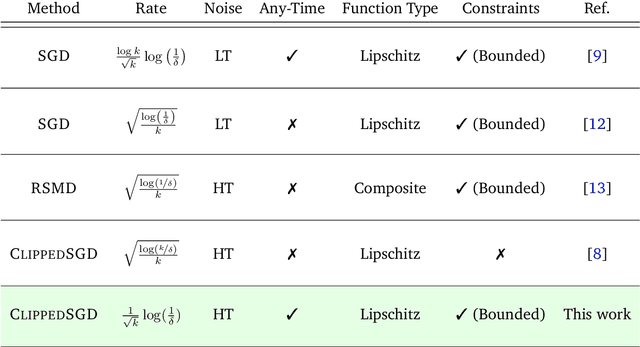

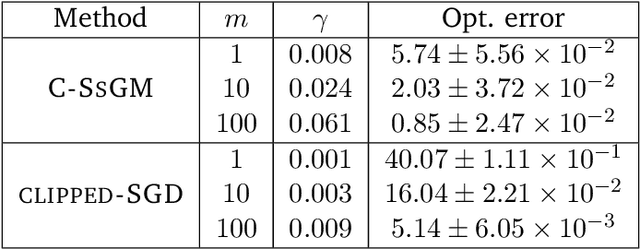
Abstract:In this work we study high probability bounds for stochastic subgradient methods under heavy tailed noise. In this case the noise is only assumed to have finite variance as opposed to a sub-Gaussian distribution for which it is known that standard subgradient methods enjoys high probability bounds. We analyzed a clipped version of the projected stochastic subgradient method, where subgradient estimates are truncated whenever they have large norms. We show that this clipping strategy leads both to near optimal any-time and finite horizon bounds for many classical averaging schemes. Preliminary experiments are shown to support the validity of the method.
A Near-Optimal Algorithm for Univariate Zeroth-Order Budget Convex Optimization
Aug 13, 2022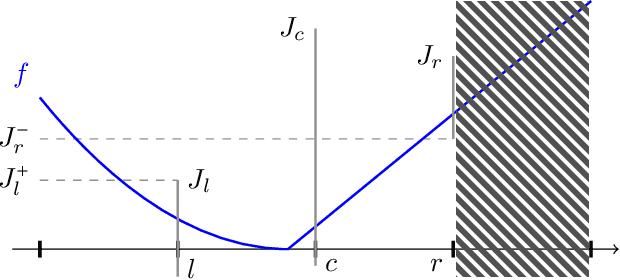

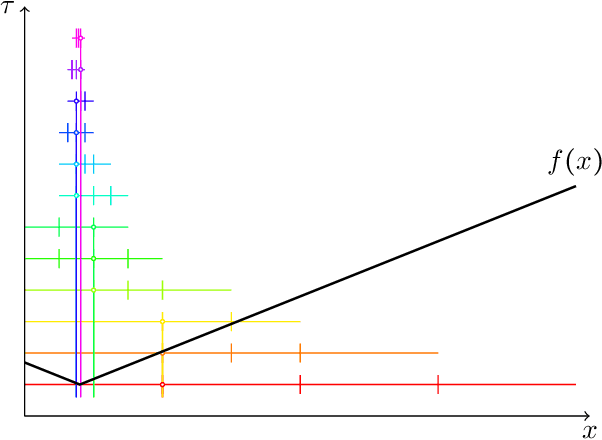
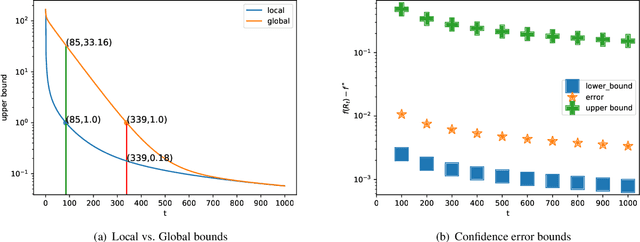
Abstract:This paper studies a natural generalization of the problem of minimizing a univariate convex function $f$ by querying its values sequentially. At each time-step $t$, the optimizer can invest a budget $b_t$ in a query point $X_t$ of their choice to obtain a fuzzy evaluation of $f$ at $X_t$ whose accuracy depends on the amount of budget invested in $X_t$ across times. This setting is motivated by the minimization of objectives whose values can only be determined approximately through lengthy or expensive computations. We design an any-time parameter-free algorithm called Dyadic Search, for which we prove near-optimal optimization error guarantees. As a byproduct of our analysis, we show that the classical dependence on the global Lipschitz constant in the error bounds is an artifact of the granularity of the budget. Finally, we illustrate our theoretical findings with numerical simulations.
On Margin-Based Cluster Recovery with Oracle Queries
Jun 09, 2021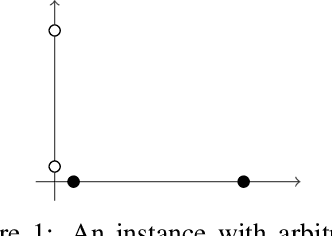
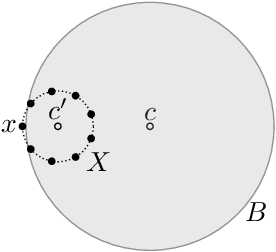
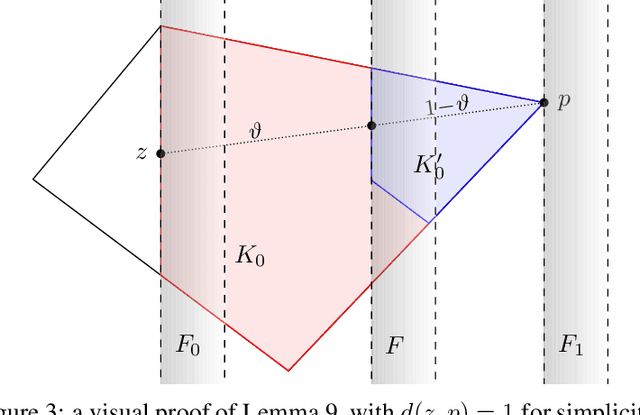
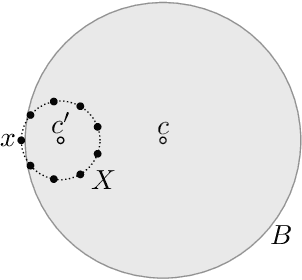
Abstract:We study an active cluster recovery problem where, given a set of $n$ points and an oracle answering queries like "are these two points in the same cluster?", the task is to recover exactly all clusters using as few queries as possible. We begin by introducing a simple but general notion of margin between clusters that captures, as special cases, the margins used in previous work, the classic SVM margin, and standard notions of stability for center-based clusterings. Then, under our margin assumptions we design algorithms that, in a variety of settings, recover all clusters exactly using only $O(\log n)$ queries. For the Euclidean case, $\mathbb{R}^m$, we give an algorithm that recovers arbitrary convex clusters, in polynomial time, and with a number of queries that is lower than the best existing algorithm by $\Theta(m^m)$ factors. For general pseudometric spaces, where clusters might not be convex or might not have any notion of shape, we give an algorithm that achieves the $O(\log n)$ query bound, and is provably near-optimal as a function of the packing number of the space. Finally, for clusterings realized by binary concept classes, we give a combinatorial characterization of recoverability with $O(\log n)$ queries, and we show that, for many concept classes in Euclidean spaces, this characterization is equivalent to our margin condition. Our results show a deep connection between cluster margins and active cluster recoverability.
Multitask Online Mirror Descent
Jun 04, 2021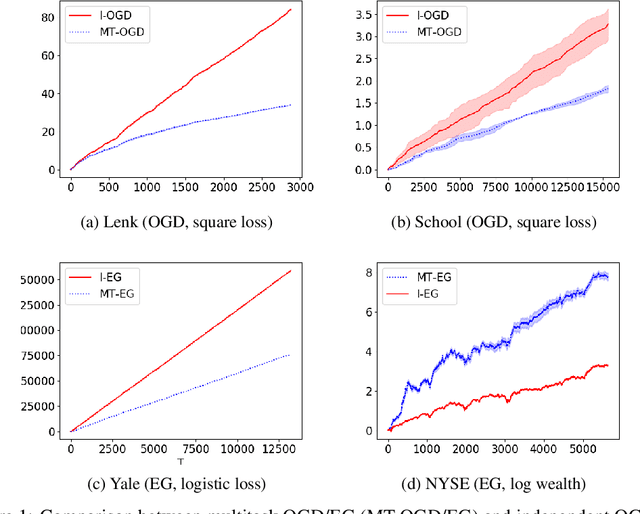
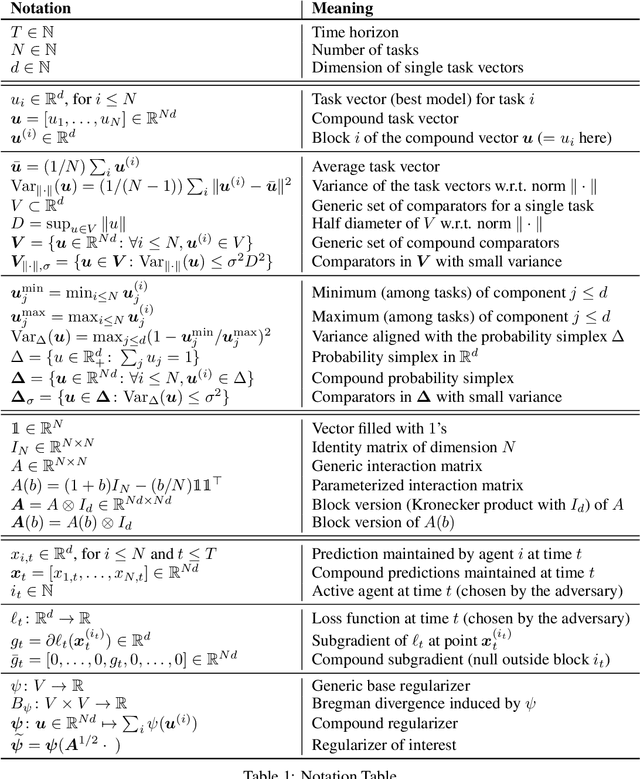
Abstract:We introduce and analyze MT-OMD, a multitask generalization of Online Mirror Descent (OMD) which operates by sharing updates between tasks. We prove that the regret of MT-OMD is of order $\sqrt{1 + \sigma^2(N-1)}\sqrt{T}$, where $\sigma^2$ is the task variance according to the geometry induced by the regularizer, $N$ is the number of tasks, and $T$ is the time horizon. Whenever tasks are similar, that is, $\sigma^2 \le 1$, this improves upon the $\sqrt{NT}$ bound obtained by running independent OMDs on each task. Our multitask extensions of Online Gradient Descent and Exponentiated Gradient, two important instances of OMD, are shown to enjoy closed-form updates, making them easy to use in practice. Finally, we provide numerical experiments on four real-world datasets which support our theoretical findings.
 Add to Chrome
Add to Chrome Add to Firefox
Add to Firefox Add to Edge
Add to Edge